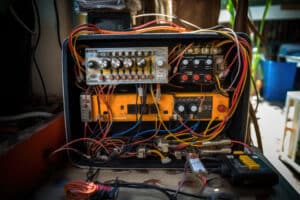How to Safely Install a Transfer Switch for a Home Generator
Key Takeaways
- Hiring a licensed professional electrician for the installation of a transfer switch is crucial to ensure safety and compliance with electrical codes.
- Load balancing is important to evenly distribute wattage requirements and prevent overloading of circuits.
- Neutral-ground bonding is a requirement in the National Electrical Code and helps prevent electrical hazards and equipment damage.
Installing a transfer switch for a home generator is crucial to ensure the safe and efficient operation of your backup power system. A transfer switch allows you to connect your generator to your home’s electrical system, providing power to essential circuits during a power outage. However, it is important to follow proper installation procedures to avoid potential hazards and ensure compliance with electrical codes. In this article, we will discuss the best practices and safety measures for installing a transfer switch for a home generator.
Hiring a Licensed Professional Electrician
One of the most important steps in safely installing a transfer switch is hiring a licensed professional electrician. A licensed electrician has the knowledge and expertise to install the transfer switch correctly, according to the manufacturer’s instructions and all local electrical codes. They will ensure that the wiring connections are secure and that the transfer switch is properly grounded.
Attempting to install a transfer switch without the necessary electrical experience can lead to serious safety risks, including electrical shock, fire hazards, and damage to your generator or electrical system. It is always best to consult a professional to ensure the installation is done correctly and safely.
Load Balancing
Load balancing is an important consideration when installing a transfer switch. It involves evenly distributing the wattage requirements of the devices connected to the transfer switch across different circuits. This prevents overloading of any single circuit and ensures that power is evenly distributed throughout your home.
When calculating your power needs, it is important to determine the total load that your generator can handle. Select a transfer switch with an amp rating that exceeds your total load to ensure it can handle the power requirements of your connected devices. This will help prevent the transfer switch from tripping or becoming overloaded during operation.
Neutral-Ground Bonding
Neutral-ground bonding is a requirement in the National Electrical Code (NEC) and plays a crucial role in the safe operation of a transfer switch. It involves connecting the neutral and ground wires together at the transfer switch. This bonding helps to prevent unintentional electrical currents and can protect against electrical shocks and equipment damage.
It is essential to follow the manufacturer’s instructions and local electrical codes when performing neutral-ground bonding. Failure to properly bond the neutral and ground wires can result in electrical hazards and may lead to code violations. A licensed electrician will ensure that the neutral-ground bonding is done correctly during the transfer switch installation.
Additional Safety Tips
In addition to the above considerations, there are several other safety tips to keep in mind when installing a transfer switch for a home generator:
- Train all users on the proper switching sequence to prevent power surges or backfeeding. Consider an automatic transfer switch to eliminate this risk.
- Place the generator and transfer switch in well-ventilated areas to prevent carbon monoxide buildup.
- Schedule routine inspections, tighten connections, and clean the transfer switch as recommended by the manufacturer.
- Familiarize yourself with safety labels and follow instructions diligently.
- Conduct regular system tests according to the manufacturer’s recommendations.
- Follow safe fuel handling practices, store fuel in approved containers, and always shut off the generator before refueling.
- Install fire extinguishers in accessible locations, train users on their use, and have a fire safety plan in place.
- Keep detailed records of installation dates, maintenance activities, and test results for reference.
By following these safety tips and hiring a licensed professional electrician, you can ensure the safe and reliable installation of a transfer switch for your home generator. It is important to prioritize safety and comply with all relevant electrical codes to protect your property and the well-being of your family during power outages.
Related Websites:
FAQs:
Q: What is a transfer switch and why is it necessary?
A transfer switch is a device that allows you to safely connect a home generator to your electrical system. It is necessary because it ensures a seamless transition of power during an outage, preventing any damage to your generator or electrical system.
Q: What are the potential risks associated with not using a transfer switch?
Not using a transfer switch can pose serious risks such as backfeeding, where power from the generator flows back into the utility lines, endangering utility workers. It can also damage appliances and electronics due to power surges when the utility power is restored.
Q: What are the key considerations before installing a transfer switch?
Before installing a transfer switch, it is important to evaluate the power requirements of your house and select an appropriate switch. You should also consider the various types of transfer switches available in the market and ensure compliance with local electrical codes and regulations.
Q: What are the necessary tools and materials for a transfer switch installation?
To install a transfer switch, you will need tools such as screwdrivers, wire cutters, and pliers. Necessary materials include electrical cables, conduit, and mounting brackets. It is crucial to use high-quality components for safety and reliability.
Q: What are the steps involved in installing a transfer switch?
The installation process includes turning off the main electrical supply, mounting the transfer switch in a suitable location, connecting it to the electrical panel, and establishing connections between the generator and the switch. Finally, the installation should be tested to ensure proper functionality.






